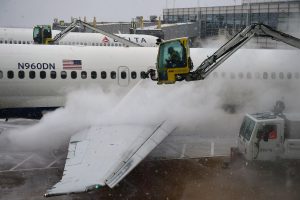It’s been cold here in Seattle and across many parts of the country over the last several days. All week long I have had the pleasure of scraping an inch of ice and frost off my windshield each morning. If my car’s windshield is icing over, the same can probably be said for all the aircraft parked on the ramp at the local airport. As a pilot, whether you are flying a sport aircraft or a 737 it’s important to understand the effects of frost and ice on you aircraft, particularly the lifting surfaces.
Frost is described as ice deposits formed on a surface when the temperature of the collecting surface is at or below the dew point of the adjacent air, and the dew point is below freezing. Frost causes early airflow separation on an airfoil resulting in a loss of lift. Therefore, all frost should be removed from the lifting surfaces of an airplane before flight or it could prevent the airplane from becoming airborne.
Test data indicates that ice, snow, and frost formations having a thickness and surface roughness similar to medium or coarse sandpaper on the leading edge and upper surface of a wing can reduce wing lift by as much as 30%, and increase drag by 40%.
Prior to flight, it is extremely important that the aircraft is completely cleaned and clear of any frost or ice. This is often accomplished through deicing.
Deicing is a procedure in which frost, ice, or snow is removed from the aircraft in order to provide clean surfaces. You may often see ground deicing accomplished by applying a fluid solution containing glycol and various other chemical agents to the aircraft. The image below depicts a typical commercial airliner going through a deicing process using a glycol solution. If you do not have deicing fluid on hand, simply moving your aircraft into a heated hanger for a short period of time will solve the problem. However, it’s important the water resulting from the melting is wiped off or you could encounter a re-freeze as you taxi to the runway. Other times all it takes is a quick brushing of the aircraft to remove frost from the surfaces.

Take a look at some of these sample Private Pilot test question dealing with frost and ice.
1. Which conditions result in the formation of frost?
A—The temperature of the collecting surface is at or below freezing when small droplets of moisture fall on the surface.
B—The temperature of the collecting surface is at or below the dewpoint of the adjacent air and the dewpoint is below freezing.
C—The temperature of the surrounding air is at or below freezing when small drops of moisture fall on the collecting surface.
2. Why is frost considered hazardous to flight?
A—Frost changes the basic aerodynamic shape of the airfoils, thereby decreasing lift.
B—Frost slows the airflow over the airfoils, thereby increasing control effectiveness.
C—Frost spoils the smooth flow of air over the wings, thereby decreasing lifting capability.
3. How does frost affect the lifting surfaces of an airplane on takeoff?
A—Frost may prevent the airplane from becoming airborne at normal takeoff speed.
B—Frost will change the camber of the wing, increasing lift during takeoff.
C—Frost may cause the airplane to become airborne with a lower angle of attack at a lower indicated airspeed.




